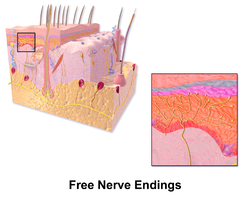Free nerve ending
| Free nerve ending | |
|---|---|
 Illustration of free nerve endings | |
| Details | |
| Identifiers | |
| Latin | terminatio neuralis libera |
| TH | H3.11.06.0.00002 |
| FMA | 84005 |
| Anatomical terms of neuroanatomy | |
A free nerve ending (FNE) or bare nerve ending, is an unspecialized, afferent nerve fiber sending its signal to a sensory neuron. Afferent in this case means bringing information from the body's periphery toward the brain. They function as cutaneous nociceptors and are essentially used by vertebrates to detect noxious stimuli that often result in pain.
Structure[]
Free nerve endings are unencapsulated and have no complex sensory structures. They are the most common type of nerve ending, and are most frequently found in the skin. They penetrate the dermis and end in the stratum granulosum. FNEs infiltrate the middle layers of the dermis and surround hair follicles.
Types[]
Free nerve endings have different rates of adaptation, stimulus modalities, and fiber types.
Rate of adaptation[]
Different types of FNE can be rapidly adapting, intermediate adapting, or slowly adapting. A delta type II fibers are fast-adapting while A delta type I and C fibers are slowly adapting.[1][2]
Modality[]
Free nerve endings can detect temperature, mechanical stimuli (touch, pressure, stretch) or danger (nociception). Thus, different free nerve endings work as thermoreceptors, cutaneous mechanoreceptors and nociceptors. In other words, they express polymodality.
Fiber types[]
The majority of Aδ (A delta) fibers (group III) and C (group IV) fibers end as free nerve endings.
References[]
- ^ Rolf-Detlef Treede, Richard A.Meyer, Srinivasa N.Raja, James N.Campbell. Evidence for two different heat transduction mechanisms in nociceptive primary afferents innervating monkey skin. J Physiol 1995;483:747-758
- ^ Churyukanov M, Plaghki L, Legrain V, Mouraux A (2012). "Thermal detection thresholds of Aδ- and C-fibre afferents activated by brief CO2 laser pulses applied onto the human hairy skin". PLOS ONE. 7 (4): e35817. Bibcode:2012PLoSO...735817C. doi:10.1371/journal.pone.0035817. PMC 3338467. PMID 22558230.
External links[]
- MacIver M, Tanelian D (1993). "Free nerve ending terminal morphology is fiber-type-specific for A delta and C fibers innervating rabbit corneal epithelium". J Neurophysiol. 69 (5): 1779–83. doi:10.1152/jn.1993.69.5.1779. PMID 8509835.
- Nociception: Transduction. From the University of Utah.
- Hada R (1990). "[Difference in responses of free nerve endings and Ruffini-type endings innervating the cat mandibular periosteum to square wave pressure stimuli, ramp mechanical stimuli and triangular vibrations]". Shikwa Gakuho. 90 (2): 161–80. PMID 2135092.
- Textbook in Medical Physiology And Pathophysiology: Essentials and clinical problems. Copenhagen Medical Publishers. 1999 - 2000
- Cleland C, Hayward L, Rymer W (1990). "Neural mechanisms underlying the clasp-knife reflex in the cat. II. Stretch-sensitive muscular-free nerve endings". J Neurophysiol. 64 (4): 1319–30. doi:10.1152/jn.1990.64.4.1319. PMID 2258749.
- Somatosensory System from Dr. Daley of North Carolina Wesleyan College.
- Somatosensory system